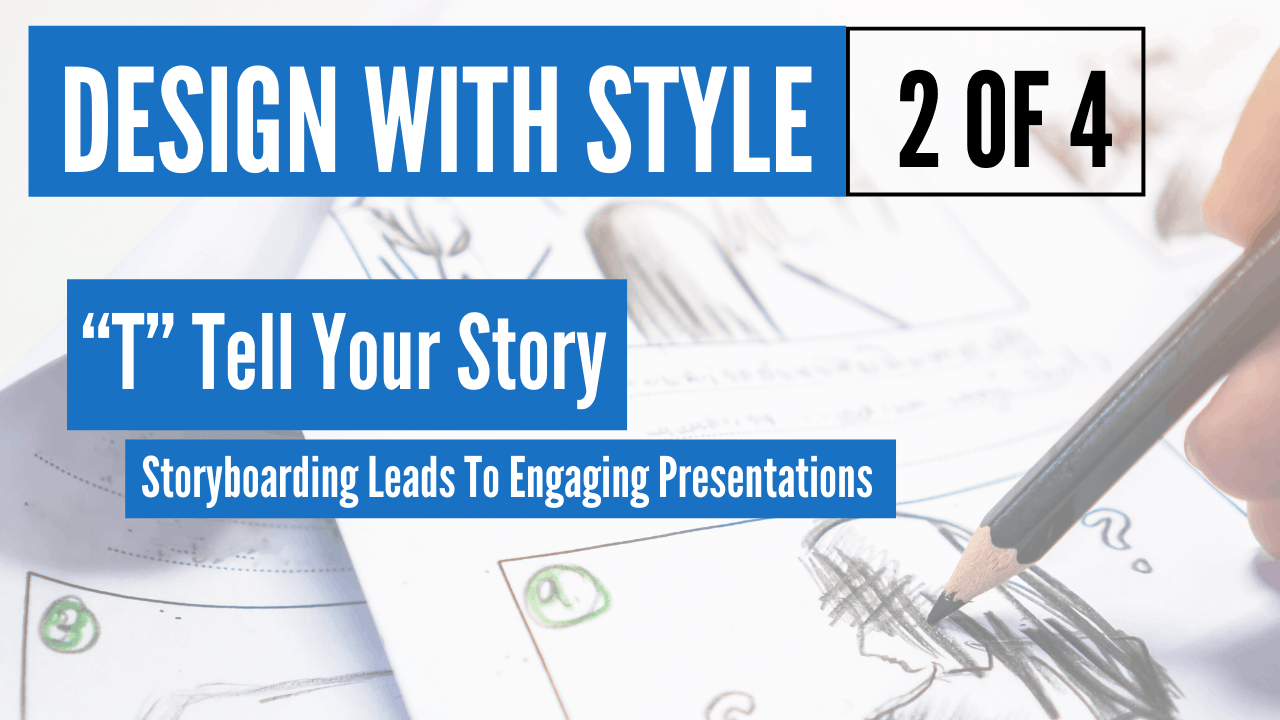PART 2
This second installment in our Presentation Design series unlocks one of the secrets of great slide design. We’re keying in on the foundational process of storyboarding. Welcome to Part 2 of Design with STYLE – The STYLE Method!
In Part 1, we learned that Presentation Design is based on several decades of neuroscience research and visual design theory. This research serves up the special sauce that goes into great presentations.
Now think about any dramatic or artistic presentation you’ve seen.
The Broadway version of “Hamilton.” The Academy Award-nominated film “1917.” There’s a rhythm and a flow to stories told on stage and on the silver screen. A similar structure needs to exist in your presentation.
Storyboarding is a first step in creating a presentation’s style and flow. It’s a simple but crucial tool for mapping out the visual storytelling that will add to your speech. A storyboard helps you put key points in order. Edit out unnecessary parts. And visualize each of your slides.
A storyboard is the equivalent of a graphic organizer. It’s a crucial tool in the belt of every Oscar-aspiring writer, director or cinematographer…and anybody preparing to create a business presentation.
Table of Contents
ToggleStoryboarding Leads To Powerful Presentations
In short: a storyboard is a basic but visually enhanced outline of your presentation.
This powerful tool is an initial step that helps you order key parts of your speech as well as edit out unneeded portions.
Here’s how to create a storyboard:
- Pick a tried-and-true storyboard structure that best dramatizes your message. More on that below.
- Write down the major points of your speech on sticky notes—one for each individual storyboard frame. Leave room on each for a rough drawing.
- Draw a quick sketch on each topic card that’s a visual for that topic.
- Lay these cards out on a table or white-board. Move them into the order you would like to present them that fits the structure and sells your message.
While storyboarding, remember: Slides are not teleprompters. Reading off the screen is a guaranteed way to bore and annoy your audience.
Don’t worry. If you need help with this we can show you ways to rehearse and recall your lines without clogging up your beautiful slide design with bullet points. Schedule a consultation or check out our presentation design services here.
“T” Tell Your Story: A Structured Journey
Think about your presentation as a journey.
You’re taking an audience from Point A to Point B. Maybe you want people to buy a product, invest in a cause or get folks to think a certain way.
Your storyboard should outline how you’ll take the audience on this figurative journey.
Effective storyboards can be outlined in at least a half dozen types of story structures, including:
- The Explanation, which teaches new insights or abilities. This method starts by creating the lay of the land, then shows a roadmap, first steps and next steps toward an idea. Closing slides show the “imminent arrival” and lead up to the “ultimate arrival” at the new destination.
- The Pitch recommends a new action or solution. It starts with a windup—but a hurdle is introduced. Then we show the vision, the options and then head for the closing solution. Now that the audience is excited, we offer the fine print on how we make it happen.
- The Drama is based on a hero’s journey, and inspires a new way of looking at the world. We start with a one-fine-day scenario, then we hit a challenge and descend into crisis. We hit rock bottom, but then there’s a discovery, a rise, the hero’s return and an explanation of the lesson we’ve learned.
- Situation-Complication-Resolution is common in the consulting and B2B sales worlds, and utilizes a BUT & THEREFORE structure. A situation unfolds BUT there is a complication, THEREFORE we must come to a resolution.
- Situation-Opportunity-Resolution is a variation of the previous structure. The difference is that in the middle of the presentation the audience is faced with an opportunity instead of a complication.
- Hook, Meat & Payoff is a structure that aims to quickly engage an audience. The hook can be a rhetorical question, provocative statement or a personal story. When the crowd is engaged, the meat can come in the form of a list or timeline that fosters understanding. The payoff at the end circles back to the hook that serves up an effective conclusion.
Presentation Design Services
Slide In Safely and Let Us Help!
When you need professional assistance with presentation design – individually or as a team – Moxie Institute can help you with:
- Business Presentation and Slide Design
- Presentation Design Coaching
- Design Team Training and Workshops
- Slide Review Services
“Y” = Your Slide Design!
In our next blog, we’ll cover the “Y” in the STYLE Method. “Y” = Your Slide Design. We’ll dive into the style and structure principles that go into a memorable presentation. Look for tips on how to best use templates, themes and topography—and we’ll also examine the power that comes with color!
TAKE THE FIRST STEP TO MASTER POWERFUL NEW SKILLS
Schedule an easy 30-minute call using our calendar. We’re here to help!











